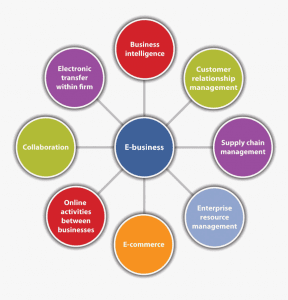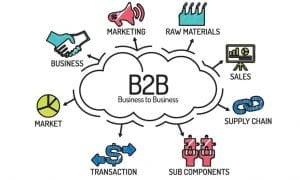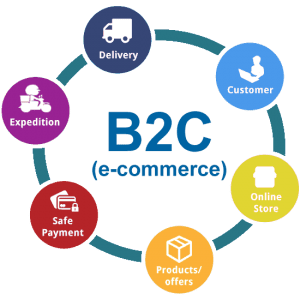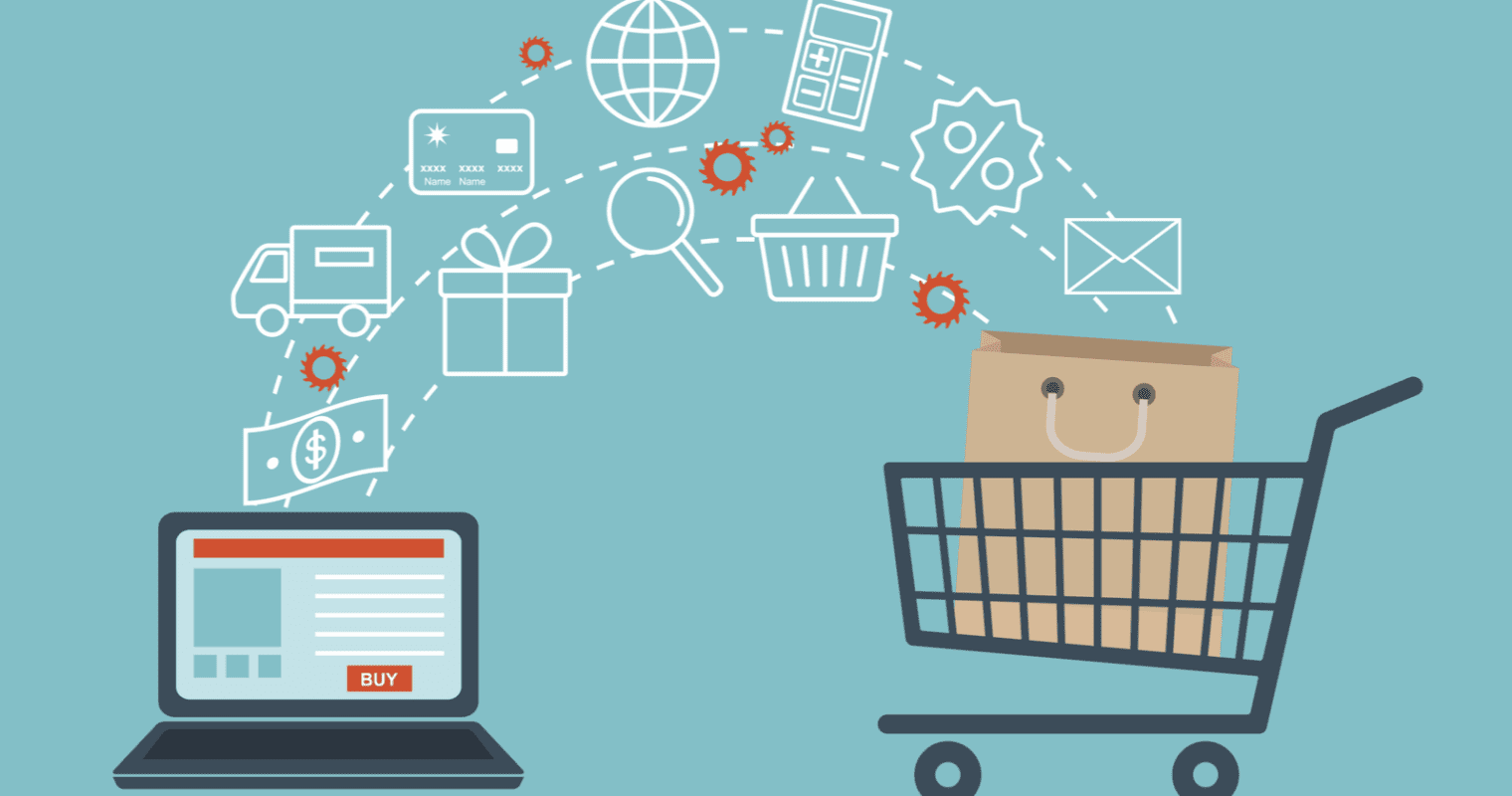E-Commerce is an improved and effective tool for business in the present automated world, and it also plays a dominant role in communication both intra-companies and inter-companies and also between companies and consumers, asserts. E-commerce is an exemplary concept in the future of textile and apparel industry. It is playing a major role in the present scenario of textile and apparel industry. It is also very significant that the future of textile and apparel industry is complete only with E-commerce. Diverse e-commerce applications are being implemented in the textile and apparel supply chain. Information and communication technologies (ICTs) have the capacity to make extravagant amounts of information available to users located in various parts of the world. ICTs also facilitate rapid communication between them. One application of these technologies is in the development of e-commerce to support electronic trading.
E-commerce: A new concept and scope

source: https://businessanalystlearnings.com/ba-techniques/2017/9/23/requirements-scope-statements
E-commerce can be specified as any form of economic activity conducted through computer-mediated networks. The potential of e-commerce caught the public attention as a result of ventures such as the electronic bookshop. As a result there are a growing number of other Internet-based retailers in the business-to-consumer (B2C) e-commerce area. However, business-to-business (B2B) e-commerce is growing much more quickly than B2C forms of electronic trading. E-commerce is a new and exciting technology, attracting much interest. It has the power of fundamentally changing the ways in which companies do business. It is having a profound effect on the management of the supply chain. Aspects of e-commerce are much diversified.
E-commerce has a large impact on industry as a whole, including aspects associated with Business-to-consumer (B2C) e-commerce, business-to- business (B2B) e-commerce. In recent years there has been a dramatic increase in companies practicing electronic commerce. Two basic modes of organising such companies have emerged. The first is creating a “brick-and mortar” company, by installing an e-commerce division.
The second is initiation of an enterprise as an electronic commerce company (dot.com), without previous organisational links to a traditional “brick-and-mortar” organisation. Both modes of corporate practice of electronic commerce require redesign, recalibration, and even restructuring of key organisational dimensions. In such companies, there is also a question of applicability of traditional organisational dimensions to this new format of conducting commerce. As electronic markets and electronic commerce proliferate, there has been a marked increase in scientific studies of this phenomenon.
The emerging conventional wisdom suggests that electronic commerce is different enough to warrant an in-depth examination of traditional organisation design in the present global scenario; e-commerce and e-business have increasingly become a necessary component of business strategy. E-commerce also acts as a strong catalyst for economic development. The integration of information and communications technology (ICT) in business has heavily improved inter organisation relationships and intra organisational relationships. Specifically, the use of ICT in business has improved productivity, encouraged greater customer participation, and enabled mass customisation and has also reduced costs.
With the help of developments in the Internet and Web-based technologies, distinctions between traditional markets and the global electronic marketplace are gradually being narrowed down. The strategic positioning, the ability of a company to determine emerging opportunities and utilise the necessary human capital skill is the main aim of each and every firm. To make the most of these opportunities through an e-business strategy that is simple, workable and practicable within the context of a global information milieu and new economic environment is the focus of e-commerce. E-commerce coupled with the appropriate strategy and policy approach enables small and medium scale enterprises to compete with large and capital-rich businesses.
E-Commerce as E-business

source: https://www.kindpng.com/imgv/ThRiTJJ_e-business-png-image-background-scope-of-e/
E-commerce is an improved version of the existing traditional business without the involvement of human beings but only uses the electronic media. While some use e-commerce and e-business interchangeably, they are distinct concepts. In e-commerce, information and communications technology (ICT) is used in inter organisations or intra organisational transactions and in business-to-consumer transactions.
In e-business, on the other hand, ICT is used to enhance one’s business. It includes any process that a business organisation (either a for-profit, governmental or non-profit entity) conducts over a computer-mediated network. A more comprehensive definition of e-business is: “The transformation of an organisation’s processes to deliver additional customer value through the application of technologies, philosophies and computing paradigm of the new economy.”
Three primary processes are enhanced in e-business:
- Production processes, which include planning of raw materials, ordering, procurement and replenishment of stocks from time to time; processing of payments; links with suppliers through e-media; and production control processes.
- Customer-focused processes, which include promotional and marketing efforts, selling over the Internet, processing of customers’ purchase orders and payments, and customer support, among others, providing after sales support.
- Internal management processes, which include employee services, training, internal information-sharing, video-conferencing, and recruiting. Electronic applications enhance information flow between production and sales forces to improve sales force productivity.
Categories of E-commerce
The major different types of e-commerce are:
- Business-to-business (B2B)
- Business to-consumer (B2C)
- Consumer-to-consumer (C2C)
B2B E-commerce
B2B E-commerce is defined as e-commerce between companies. This is the type of e-commerce that deals with relationships between and among businesses. About 80% of e-commerce is of this type, and most experts predict that B2B e-commerce will continue to grow faster than the B2C segment. The B2B market has two primary components: e-infrastructure and e-markets. E infrastructure is the architecture of B2B, primarily consisting of the following:
- Logistics – transportation, warehousing and distribution.
- Application service providers – deployment, hosting and management of packaged software from a central facility.
- Outsourcing of functions in the process of e-commerce, such as Web-hosting, security and customer care solutions.
- Auction solutions software for the operation and maintenance of real-time auctions in the Internet.
- Content management software for the facilitation of Web site content management and delivery.
- Web-based commerce enablers.
- E-markets are simply defined as Websites where buyers and sellers interact with each other and conduct transactions.

source: https://datafloq.com/read/b2b-ecosystems-big-data-transform-sales-marketing/2716
Most B2B applications are in the areas of supplier management (especially purchase order processing), inventory management (i.e., managing order-ship-bill cycles), distribution management (especially in the transmission of shipping documents), channel management (i.e., information dissemination on changes in operational conditions), and payment management (e.g., electronic payment systems or EPS).
B2C E-commerce
Business-to-consumer e-commerce, or commerce between companies and consumers, involves customers gathering information; purchasing physical goods (ie, tangibles such as books or consumer products) or information goods (or goods of electronic material or digitized content, such as software, or e-books); and, for information goods, receiving products over an electronic network. It is the second largest and the earliest form of e-commerce. Its origins can be traced to online retailing (or e-tailing). B2C examples involving information goods are E-Trade and Travelocity. The more common applications of this type of e-commerce are in the areas of purchasing products and information, and personal finance management, which pertains to the management of personal investments and finances with the use of online banking tools.

source: https://www.wedoeconsult.com/what-is-digital-marketing/b2c_development/
C2C E-commerce
Consumer-to-consumer e-commerce or C2C is simply commerce between private individuals or consumers. This type of e-commerce is characterised by the growth of electronic marketplaces and online auctions, particularly in vertical industries where firms/businesses can bid for what they want from among multiple suppliers. This paves way for developing new markets. This type of e-commerce comes in at least three forms:
- Auctions facilitated at a portal.
- Peer-to-peer systems, such as the Napster model (a protocol for sharing files between users used by chat forums similar to IRC) and other file exchange and later money exchange models.
- Classified ads at portal sites.

source: https://www.dreamstime.com/illustration/c2c.html
Benefits of E Commerce
Benefits of e-commerce include global marketing opportunities for products and markets. However, a key limitation of e-commerce is the risk of channel conflict between existing customers and new profile customers. With the continued globalization emphasis of the textile and apparel supply chain, analyses and creative implementation of e-commerce applications may offer unique product and market opportunities. Some benefit of e commerce are as follows:
- Decrease in cost
The cost incurred on advertisement and communication is lower as the business uses e-mail and online advertising channels, The cost incurred on human resources is also low as most of the business processes are automated. Middlemen are eliminated to a considerable extent as there is a direct link between the business and the consumers.
- Effective customer service
E-commerce through internet provides up-to-date information about the business and its products to customers. By answering customers’ queries quickly and arranging immediate delivery of goods, a business organization is able to win the loyalty of customers. Effective communication and quick delivery of goods lead to total customer satisfaction.
- Transaction efficiency
Automation of business processes helps the business to streamline its operating processes. Efficient procurement cycles reduce delivery delays. Minimum time taken to complete transactions also results in transaction efficiency.
- Effective information management
E-Commerce helps business to create, process, distribute, store and retrieve any information cheaply and quickly. The above benefits enable a business organization to remove any communication gap between the business and consumer, or between business and business associates or between business and its employees.
Communication is considered as the lifeblood of any business organization. Good information management enables the top level management to take quick decisions and make use of the business opportunities at the right time. E-Commerce helps at every stage for an effective information management.
- Global reach
Business organizations are able to send messages worldwide with the help of electronic medium, explore new markets and reach globally at lower cost. E-commerce helps to attract customers and business clients from anywhere in the world due to global reach of the internet.
Companies that are Working with E Commerce
Welspun India

source: https://www.vccircle.com/temasek-exits-home-textiles-maker-welspun-india-huge-haircut/
The company has incorporated a wholly-owned subsidiary Welspun Nexgen Inc registered with the state of Delaware, US having paid up capital of USD 4.25 million to make investment in e-commerce companies,” Welspun India said in a BSE filing.
Official Website: https://www.welspun.com/
Bombay Dyeing

source:https://www.citymapia.com/kottayam/centur-bombay-dyeing/products/cotton-bombay-dyeing-school–16463
Bombay Dyeing, the 133-year-old textile company of the Wadia group, plans to enter the e-commerce space by launching its e-tailing site to sell its bed and bath products soon, said sources from the company.
Though Bombay Dyeing’s sells its products at 350 exclusive outlets and 2,000 multi-brand outlets, the e-commerce plan is to create another revenue stream for the company. The e-commerce route is less expensive compared to others.
Official Website: https://bombaydyeing.com/
Trident Group

source: https://www.linkedin.com/company/tridentgroupindia
Trident Group is one of the leading suppliers of home textiles products globally and is well known in the international market, for its textile and paper business. Amazon has announced the launch of products by the Ludhiana-based, Trident Limited, the flagship company of Trident Group on its global marketplace Amazon.com, bringing its wide range of offerings to consumers worldwide as a part of Amazon’s global selling programme. According to the company, by partnering with Amazon, Trident Group can now sell to millions of potential global customers who value not only the high-quality products but are also conscious of the environmental impact of their consumption.
Official Website: https://www.tridentindia.com/
Arvind Limited

source: https://www.nextbigbrand.in/arvind-ltd-brand-that-put-india-into-global-map-of-denim-manufacturing/
Arvind Ltd, India’s leading textile and apparel manufacturer, is expecting its sales from e-commerce to rise in the coming months despite uncertainty in the sector after tightening of norms by the government for e-commerce companies in the country. Arvind Ltd believes that the recent amendments in the sector will have very little impact on the e-commerce sector and is confident that the sector will be back on track in some time. The company expects its online sales from e-commerce firm to double in the coming years. Currently, online sales contribute around 15 percent to the company’s overall revenues and it expects to be around 30 percent in the next few years.
Official Website: https://www.arvind.com/
Reference
https://www.fibre2fashion.com/industry-article/4179/e-commerce-in-textile-and-apparel-a-future-trend
https://indiantextilejournal.com/articles/FAdetails.asp?id=4055
https://textiles.ncsu.edu/tatm/wp-content/uploads/sites/4/2017/11/daly_full.pdf

Article Writtten By-
Ms. Sidrah Mubin Patel. B.Sc. in Textiles and Apparel Designing, Sir Vithaldas Thackersey College of Home Science.
Textile Value Chain Intern. Email: tvcmedia.digital@gmail.com

